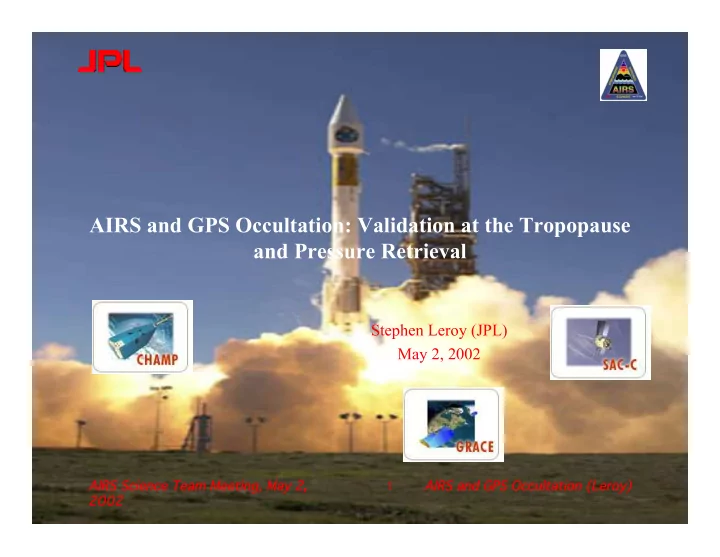

AIRS and GPS Occultation: Validation at the Tropopause and Pressure Retrieval Stephen Leroy (JPL) May 2, 2002 AIRS Science Team Meeting, May 2, AIRS and GPS Occultation (Leroy) 1 2002
Outline • What are occultations? Characteristics and examples. • How can they be useful for AIRS? Validation in certain limits. • Data availability. http://genesis.jpl.nasa.gov. AIRS Science Team Meeting, May 2, AIRS and GPS Occultation (Leroy) 2 2002
Outline • What are occultations? Characteristics and examples. • How can they be useful for AIRS? Validation in certain limits. • Data availability. http://genesis.jpl.nasa.gov. AIRS Science Team Meeting, May 2, AIRS and GPS Occultation (Leroy) 3 2002
GPS Occultation Technique • Active microwave limb sounding • Two frequencies (1.2 and 1.6 GHz) to eliminate ionosphere • Vertical resolution ~100 m, horizontal resolution ~300 km • Insensitive to usual calibration errors æ clocks eliminated by “double-differencing” AIRS Science Team Meeting, May 2, AIRS and GPS Occultation (Leroy) 4 2002
GPS Occultation Technique (cont’d) •~250 soundings per day per receiver •Soundings are globally random but roughly follow orbit track •GPS/MET (1995-7) was proof-of-concept •Profiles refractivity: N =77.6 p / T + 3.73e5 p w / T 2 AIRS Science Team Meeting, May 2, AIRS and GPS Occultation (Leroy) 5 2002
An example occultation AIRS Science Team Meeting, May 2, AIRS and GPS Occultation (Leroy) 6 2002
An example occultation (cont’d) AIRS Science Team Meeting, May 2, AIRS and GPS Occultation (Leroy) 7 2002
Horizontal resolution issues AIRS Science Team Meeting, May 2, AIRS and GPS Occultation (Leroy) 8 2002
Outline • What are occultations? Characteristics and examples. • How can they be useful for AIRS? Validation in certain limits. • Data availability. http://genesis.jpl.nasa.gov. AIRS Science Team Meeting, May 2, AIRS and GPS Occultation (Leroy) 9 2002
Predicted accuracy, polar lat’s 60 50 40 Altitude (km) RSS 30 5 ) thermal noise (SNR 0 =5x10 local multipath horiz along-track 20 ionos night, sol max abel boundary: dH/H=5% hydrostatic boundary 10 o lat, 8km cor len H 2 O at 80 0 0.1 1 10 Temperature Error (K) From Kursinski et al. (2000) AIRS Science Team Meeting, May 2, AIRS and GPS Occultation (Leroy) 10 2002
Predicted accuracy, equatorial lat’s 60 50 40 Altitude (km) RSS thermal error (SNR 0 =5x10 4 ) 30 local multipath horiz along-track horiz drift ionos day, sol max 20 abel boundary: dH/H=5% abel boundary: 7%dalpha hydrostatic boundary H 2 O at 0 o lat, 0.5km cor len 10 0 0.1 1 10 Temperature Error (K) AIRS Science Team Meeting, May 2, AIRS and GPS Occultation (Leroy) 11 2002
Comparison to ECMWF profiles AIRS Science Team Meeting, May 2, AIRS and GPS Occultation (Leroy) 12 2002
Comparison to ECMWF analysis From Leroy (1997) AIRS Science Team Meeting, May 2, AIRS and GPS Occultation (Leroy) 13 2002
Validation of MSU timeseries 214 NCEP 0 MSU Channel 4 Brightness channel 4 (K) Radio occultation Uncertainty band 200 hPa Time slot Pressure (hPa) Channel 2LT 210 271 Brightness channel 2LT (K) 1000 0 5 Weight (%) MSU 230 NCEP 267 MSU Brightness channel 4 (K) Radio occultation 12.1 Geopotential 200hPa (gkm) NCEP, Radio occultation 200 90 0 -90 11.9 Latitude 1-Jan-95 1-Jan-02 Northern spring, 1995. From Schrøder et al. (2002) AIRS Science Team Meeting, May 2, AIRS and GPS Occultation (Leroy) 14 2002
Outline • What are occultations? Characteristics and examples. • How can they be useful for AIRS? Validation in certain limits. • Data availability. http://genesis.jpl.nasa.gov. AIRS Science Team Meeting, May 2, AIRS and GPS Occultation (Leroy) 15 2002
Current and planned missions SAC-C CHAMP Comisión Nacional de Actividades Geophysikalisches Forschungszentrum (Potsdam), JPL Espaciales (Buenos Aires), JPL Launched July 15, 2000 Launched January 25, 2001 i =98.2º, z =702km, T=98.8mins, 10:15LT i =87º, z =454km, T=93.55mins, T n =966 days Collecting occ’ns since July 7, 2001 Collecting occ’ns since April 6, 2001 genesis.jpl.nasa.gov genesis.jpl.nasa.gov GRACE University of Texas, JPL, DLR Launched March 17, 2002 Two spacecraft, i =89-90º, z =300-500km Begin occ’n profiling July, 2002, 250-500 occ’ns/day genesis.jpl.nasa.gov AIRS Science Team Meeting, May 2, AIRS and GPS Occultation (Leroy) 16 2002
Local time coverage AIRS Science Team Meeting, May 2, AIRS and GPS Occultation (Leroy) 17 2002
Possible plan for AIRS validation • Regular co-locations at polar latitudes • Episodic co-locations globally (SAC-C, GRACE) • Asynchronous validation – probably require many footprints to cover horizontal extent of occultation! • http://genesis.jpl.nasa.gov - provides occultation data in HDF-EOS AIRS Science Team Meeting, May 2, AIRS and GPS Occultation (Leroy) 18 2002
Retrieve pressure • GPS’s absolute position information, when convolved with a gravity model, provides heights of constant pressure surfaces. • As research, one can combine 3D AIRS data with occultation data to retrieve height information for all AIRS footprints. AIRS Science Team Meeting, May 2, AIRS and GPS Occultation (Leroy) 19 2002
Recommend
More recommend